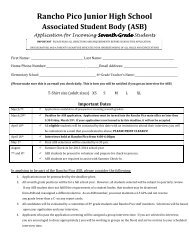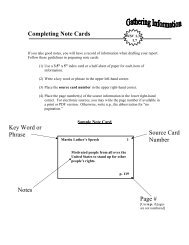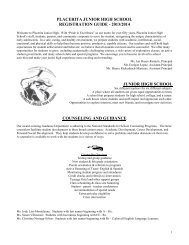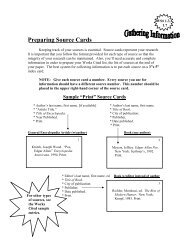Safe School Plan - William S. Hart Union High School District
Safe School Plan - William S. Hart Union High School District
Safe School Plan - William S. Hart Union High School District
You also want an ePaper? Increase the reach of your titles
YUMPU automatically turns print PDFs into web optimized ePapers that Google loves.
Time. Fallout radiation loses its intensity fairly rapidly. In time, you will be able to leave the fallout shelter. Radioactive fallout<br />
poses the greatest threat to people during the first two weeks, by which time it has declined to about 1% of its initial radiation level.<br />
Remember that any protection, however temporary, is better than none at all, and the more shielding, distance and time you can take<br />
advantage of, the better.<br />
Electromagnetic pulse<br />
In addition to other effects, a nuclear weapon detonated in or above the earth’s atmosphere can create an electromagnetic pulse (EMP), a highdensity<br />
electrical field. EMP acts like a stroke of lightning but is stronger, faster and briefer. EMP can seriously damage electronic devices<br />
connected to power sources or antennas. This includes communication systems, computers, electrical appliances, and automobile or aircraft<br />
ignition systems. The damage could range from a minor interruption to actual burnout of components. Most electronic equipment within<br />
1,000 miles of a high-altitude nuclear detonation could be affected. Battery powered radios with short antennas generally would not be<br />
affected.<br />
Although EMP is unlikely to harm most people, it could harm those with pacemakers or other implanted electronic devices.<br />
What to do before a nuclear or radiological attack<br />
1. Learn the warning signals and all sources of warning used in your community. Make sure you know what the signals are, what they mean,<br />
how they will be used, and what you should do if you hear them. AT VHS, THE SIGNAL WILL BE AN OPEN ANNOUNCEMENT<br />
OVER THE PA SYSTEM.<br />
2. Assemble and maintain a disaster supply kit with food, water, medications, fuel and personal items adequate for up to 2 weeks—the more<br />
the better.<br />
3. Find out what public buildings in your community may have been designated as fallout shelters. It may have been years ago, but start<br />
there, and learn which buildings are still in use and could be designated as shelters again.<br />
Call your local emergency management office.<br />
<br />
<br />
<br />
Look for yellow and black fallout shelter signs on public buildings. Note: With the end of the Cold War, many of the signs have been<br />
removed from the buildings previously designated.<br />
If no noticeable or official designations have been made, make your own list of potential shelters near your home, workplace and<br />
school: basements, or the windowless center area of middle floors in high-rise buildings, as well as subways and tunnels.<br />
Give your household clear instructions about where fallout shelters are located and what actions to take in case of attack.<br />
(The city of Santa Clarita has designated all high school gymnasiums, the COC gymnasium, the Community Center in Newhall<br />
and the Sports Complex as emergency shelters.)<br />
4. If you live in an apartment building or high-rise, talk to the manager about the safest place in the building for sheltering, and about<br />
providing for building occupants until it is safe to go out.<br />
5. There are few public shelters in many suburban and rural areas. If you are considering building a fallout shelter at home, keep the<br />
following in mind:<br />
<br />
<br />
A basement, or any underground area, is the best place to shelter from fallout. Often, few major changes are needed, especially if the<br />
structure has two or more stories and its basement—or one corner of it—is below ground.<br />
Fallout shelters can be used for storage during non-emergency periods, but only store things there that can be very quickly removed.<br />
(When they are removed, dense, heavy items may be used to add to the shielding.)<br />
All the items you will need for your stay need not be stocked inside the shelter itself but can be stored elsewhere, as long as you can<br />
move them quickly to the shelter.<br />
6. Learn about your community’s evacuation plans. Such plans may include evacuation routes, relocation sites, how the public will be<br />
notified and transportation options for people who do not own cars and those who have special needs.<br />
7. Acquire other emergency preparedness booklets that you may need. See the “For More Information” chapter at the end of this guide.<br />
82

















